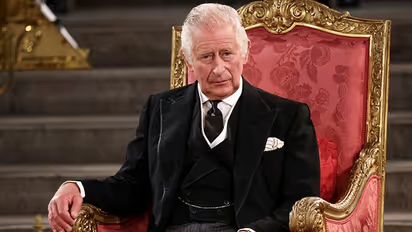Historic crown to be modified for King Charles III’s coronation in May

Synopsis
The St. Edward's Crown has been moved to an undisclosed location for modification in preparation for the coronation of King Charles III next year, Buckingham Palace said. The crown has a purple velvet cap with an ermine band and is encrusted with rubies, amethysts, sapphires, garnet, topazes and tourmalines. It is just over 30 cm (12 inches) long and has a 2.23-kilogram (4.9-pound) solid gold frame.
The famous St. Edward's Crown, which has served as the focal point of more than 350 years of royal coronations in England, has been taken out of the Tower of London so it may be altered in time for King Charles III's coronation in May, according to Buckingham Palace.
The crown, which is generally a component of the Crown Jewels on display in the Tower, has been used since the coronation of King Charles II in 1661 after the monarchy was restored following the 10-year republic of Oliver Cromwell. The St Edward's Crown replaced a medieval version, thought to have dated back to the 11th Century reign of Edward the Confessor which was melted down in 1649.
Also Read | 'Experienced racism while growing up, but ...' UK PM Rishi Sunak on Buckingham Palace fiasco
On May 6, in a solemn ceremony to be performed at Westminster Abbey in London, Charles III will receive the St. Edward's Crown, exactly as his late mother Queen Elizabeth II did in 1953. Throughout the service, he will also wear the Imperial State Crown.
The St. Edward's Crown has four crosses-pattée and four fleurs-de-lis, just like its original mediaeval forebear. It is composed of a solid gold frame adorned with rubies, amethysts, sapphires, garnet, topazes, and tourmalines. A velvet hat with an ermine band is also attached to it.
Charles III, 74, and Camilla, the Queen Consort, will both be crowned. A national holiday will be observed on May 8 after the event. The crown was created in 1661 for King Charles II to replace a mediaeval headdress that may have originated with Edward the Confessor.
Also Read: 'Experience like no other': Bear Grylls on meeting Ukraine President Volodymyr Zelensky
When his mother passed away on September 8, Charles automatically became king. In addition, he became the new head of state for 14 Commonwealth nations, among them Australia, Canada, and New Zealand.
Check the Breaking News Today and Latest News from across India and around the world. Stay updated with the latest World News and global developments from politics to economy and current affairs. Get in-depth coverage of China News, Europe News, Pakistan News, and South Asia News, along with top headlines from the UK and US. Follow expert analysis, international trends, and breaking updates from around the globe. Download the Asianet News Official App from the Android Play Store and iPhone App Store for accurate and timely news updates anytime, anywhere.